Review: BYB Tech Telemetry 2.0 - Using Data Acquisition to Improve Suspension Set Up
In the years 2020 and 2021 I didn't work on any race teams. In that time, there was a big change and it's a change that's gathering pace involving data acquisition, and how commonplace it is on the circuit. Of course, it's not entirely new. There have been one-off kits as well as production-made systems for years. So it might not just be the tech that's developing quickly but also people's attitudes around it.
Along with Motion Instruments, BYB Tech's Telemetry 2.0 is a very popular choice. The kit uses a centralized unit that receives data from different sensors, each doing a specific task.
Along with Motion Instruments, BYB Tech's Telemetry 2.0 is a very popular choice. The kit uses a centralized unit that receives data from different sensors, each doing a specific task.
BYB Telemetry 2.0
• GPS Antenna for ride tracking
• Waterproof
• Windows or Mac Compatible Software
• Android and Apple mobile app
• Compatible with brake sensors
• 500 Hz or 1000 Hz sampling rate
• 3D Printed shock and fork mounts
• Can overlay data onto GoPro footage
• 3-axis accelerometer and gyro sensors
• Price: €1,749
• bybtech.com
• GPS Antenna for ride tracking
• Waterproof
• Windows or Mac Compatible Software
• Android and Apple mobile app
• Compatible with brake sensors
• 500 Hz or 1000 Hz sampling rate
• 3D Printed shock and fork mounts
• Can overlay data onto GoPro footage
• 3-axis accelerometer and gyro sensors
• Price: €1,749
• bybtech.com
Truthfully, this review will be about how I fared, what I liked, and what I didn't when using the BYB system. The software offers so much analysis that it's something I really feel I'm only scratching the surface of. That said, if a technophobe like me can make sense of it then I think most riders should get along well. Plus, if you are more technically minded with a mind for interpreting data then the sky is the limit.
Is There Such a Thing As "The Perfect Setup"?
I've tried this system with friends and colleagues of varying levels - from weekend warriors to all-out shredders. Something I picked up quite early on is the more experience the rider had in regards to testing the more likely they were to challenge the ideals that the system suggests. It's of course a very good question. Can an objective perfect setup exist? Or is that data-derived setup just a way to fall in line with somebody else's subjective outlook?
BYB takes the approach that fastest is best. They have made a piece of software that makes starting on the system very easy, as well as helping guide the user to a central setup. In that part of the app, you put in your ability level and the software will make suggestions. When asking Enrico from BYB how they got to these settings, he explained that they were derived from crowd-sourced real-world data. They tested with riders of differing levels (the system denotes beginner, intermediate, and advanced). After testing, their fastest setup was analyzed and then fed into the app.
The Inherent Limitation of Any Data-Acquisition System
The problem with data acquisition is already in the name. It can't make a suggestion or give you data for what you haven't ridden. This means that you either want to use it on a track that you're racing on or a track that represents what you typically enjoy riding. However, even then, you will need to be cognizant of what that "bit-of-everything" track doesn't have, as much as you are aware of what it does.
The beauty of a system like this is how much it lets you maximize setup. However, that hyperfocus can mean that you end up riding close to the limit in terms of travel used. This might not be the best case if you go and find yourself riding something very different in the future. I found setups that worked exceptionally well on almost all tracks but, for instance, I love riding fast trails that are more classic racetracks than creeping-steep slabs. Where my bike would handle the repetitive hits incredibly well, it would also often be flying quite close to the sun in regards to bottom-out and would be somewhat unsuited to slower trails with single, very large compressions.
That said, no setup is perfect. If you wanted a halfway house between the two you would just have to find a test track that offered it, or hedge your bets and stray away from the data-led approach slightly. I have tended to prioritise getting bikes feeling absolutely-unbelievably-good on 95% of the trails I ride, and slightly too soft for the trails I hardly venture onto, rather than very good for everything. It's a personal approach though.
Is the Setup Derived from BYB's Data Different From a Typical One?
The setup I have ended up on is incredibly fast, and a lot softer than anything I've ever gone to previously. It quite simply required me to see in the data that this wasn't just going to eject me at the slightest hint of trouble for me to test it.
Typically, bike setup can go one of two ways - geometry preservation or chassis stability. Let's begin with talking about the fork.
A harder fork will be less likely to go into its stroke. This will keep the geometry more consistent by preventing the head angle from steepening as much as a softer setup would. Higher spring rates tend to then lead to more rebound damping being required because the spring has more force to return, meaning we need to run more damping to slow down and control the fork when it returns from big hits.
A fork with a softer spring rate will require less rebound damping to offer a similar level of control. It will also mean that the same hit will send the unit deeper into its stroke, meaning that it can make do with a lower amount of rebound damping as its return stroke is longer and will cycle more oil through the damper, giving the damper more of an opportunity to slow shaft speed. The softer, faster fork will extend into bumps and holes more easily because it has more extension available. It will also be happier to go into its stroke. Both of these factors mean that although the head angle might change dynamically, the head tube height will change less.
I would summarise the BYB-derived setup as having enough spring rate that you can get to around 80% of travel with ease in the carpark, and if you go deep off a large drop and land evenly you will use around 90% of your travel. It suggests incredibly fast rebound tunes to then return to full extension before the next hit arrives. This means your fork is far more active, but it is a trade-off, and it's not universally better.
Jumps with steep lips can be somewhat intimidating, and I found that the rebound was so fast it was better to pop less and have a more muted approach. It also meant that some bikes had rebound-induced pedal bob. That said, the climbing grip tended to be very, very good because the bike is simply so happy to go into its stroke and offered tracking on the back side of bumps, holes and obstacles that a slower rebound settings would normally inhibit.
To give you an idea of the soft settings I ended up on, I have included my settings of some common enduro forks below. In italics, I have included the recommended settings from the manufacturer for my 80 kg weight. RockShox and Ohlins suggest using the damping settings in the middle before experimentation. These aren't wrong or incorrect, but rather I just want to highlight how soft and fast I ended up running my fork. Note - all settings from fully closed.
Ohlins RXF38 M2 170mm - 100 psi main chamber / 190 psi ramp up - 104/145 psi - open rebound, 8/16LSC, 2/3HSC
Fox 38 Factory 170mm - 91 psi with 2 volume spacers - 6LSR, 5HSR, 10LSC, 5HSC - 76 psi, 2 volume spacers, 16/16 LSR, 8/8HSR, 10/16LSC, 0/8 HSC
Fox 36 Factory 160mm - 86 psi with 1 volume spacers - 6LSR, 5HSR, 10LSC, 5HSC - 78 psi, 1 volume spacer, 16/16 LSR, 6/8HSR, 8/16 LSC, 0/8 HSC
RockShox Zeb Ultimate 170mm - 60 psi with 1 volume spacer - 8LSR - 55 psi, 1 volume spacer, 16/18LSR, 14/15 LSC, 0/5 HSC
RockShox Lyrik Select+ 150mm - 78 psi with 1 volume spacer - 10LSR - 77 psi, 1 volume spacer, open rebound, 8/15 LSC, 0/5 HSC
These settings were derived from my favored test track in the Whistler Bike Park. Delayed Fuse, Shomer Shabbos, Insomnia. It's a mix of flat-out tech, both flat and steeper turns and medium to large jumps. I think it's got a bit of everything. I would describe the setup that I landed on as almost tuning the spring rate to the rebound, as opposed to the other way around. You can see that my high-speed compression settings are almost always fully closed. That's often how I setup bikes on the rear too, and then just use the low-speed adjustment to set the threshold of high-speed damping. I find this to be effective and intuitive and I can get bikes setup very well without the telemetry at this point, although it often helps.
How to Interpret the Data
The best thing about the Tune Guide isn't that it does it all for you, but rather you soon learn to interpret the data very intuitively because of what you know from the app. For instance, below is a first run on a test bike using a guestimate baseline on both shock and fork.
From the image on the left, I can see an overview of all the data. For me, this is useful but I don't care too much for speed or knowing where I've been. I've been focusing solely on how much travel I'm using, as well as how my bike is using it.
In the second image, I can immediately see that the bike is using more sag at the shock than the fork at 33% compared to 28% when measured as a dynamic value. But, interestingly, the fork is using a larger amount of travel on bigger hits. In my experience, I want my dynamic sag to be around 30% on the rear, maybe 32% max, and around 23-25% on a long-travel enduro fork. I've seen some people advocate for equal sag front and rear. I'm not against this but rather this is where I am on my journey with it.
So, why is the shock both sitting deeper, as well as not using as much travel when I really need it to? It's here I should emphasize how important a long, varied test track is, and how consistent inputs are highly valuable.
You can see to the left of the graph various boxes. Let's focus on the Velocity section. Here, we can quickly see that the average compression speeds are similar, but there is an outlier of the max speed. This can easily be addressed with high-speed compression damping. Because our average sag is a product of the entire run, reducing how a fork or shock goes deep into its stroke by altering the rate of oil flow can have a marked difference in that. I would also look at the rebound rate with keen interest. Again, the bike feels balanced, and that shows in both the average travel used as well as the average rebound, but the max rebound sees a large discrepancy between the front and rear of the bike.
My instinct, having spent 20 seconds looking at the numbers, would be to remove probably two clicks of both high-speed rebound to try and get that max speed similar to the fork (the values will be subjective but typically 3000 - 3500 m/s felt quite good to me). I would also add high-speed compression damping on the shock and go for a run. It might well be that by doing so the shock sits slightly higher in its travel because of the added compression, which could negate the need to alter the spring rate. I would also remove a click or two of Hydraulic Bottom Out (this shock had that feature) to see if I can also get more travel on big hits, all while having slowed the shaft speed down in extreme situations. Then I would go for a run and check the data again.
Much like truing a wheel, it's best to only work on the worst part at the time. Small changes that hone your sights can often be more time efficient too, and save you from bouncing around between extremes. Using the BYB system, you can get your bike feeling so well balanced within a few hours of tinkering, maybe even less if you have a track both short and varied enough. But what did the app suggest?
Something quite similar. It can be tempting to try and fix all of these issues at once but I found a methodical approach to work best. The Tune suggestions can't differentiate between high and low-speed compressions all that effectively, and don't tell you which to add. I also found that while the dynamic sag suggestion was normally very good, the bottom-out resistance could leave you vulnerable when taking the bike on bigger, rougher trails.
The Mobile App
Both the mobile and desktop apps have seen multiple updates in the duration of my test. The mobile app is very useful. For me, I can glean all the data I need from it. For racers hunting for tiny gains, it might be limited, though. BYB points out that the system is meant to be used with a laptop, first and foremost.
Here you can see some of the recommendations presented by the phone app, going from advanced, intermediate, and beginner. Without getting too granular, this is a great approach for many users and will let people dial in their bikes quickly and efficiently.
The app gives three very different flavors depending on which preference you select. Largely, advanced riders will have bikes that are both harder and faster than less experienced ones. However, the above images do highlight some limitations.
Firstly, most bikes and shocks will struggle to get rebound tunes fast enough to ever satisfy the advanced setting. It also shows that when you fly this close to the limit in terms of low spring rate and you put so much focus on using great swathes of the stroke very often, temperature fluctuations can have a large impact on how much support you have, and it can feel like you fall off a cliff sometimes. Again, this is a small limitation of the system. Every bike's spring rate will change due to temperature, of course, but there's normally just more room for error built in.
However, as much as I love this system, I think that if people do want something simple, a Shockwiz might be better suited simply for its ease of use (it's also much less expensive, although still not cheap). That said, when it comes to the nuances of setup, BYB is lightyears ahead, most of which can be accessed via the app.
Here you can see some of the recommendations presented by the phone app, going from advanced, intermediate, and beginner. Without getting too granular, this is a great approach for many users and will let people dial in their bikes quickly and efficiently.
The app gives three very different flavors depending on which preference you select. Largely, advanced riders will have bikes that are both harder and faster than less experienced ones. However, the above images do highlight some limitations.
Firstly, most bikes and shocks will struggle to get rebound tunes fast enough to ever satisfy the advanced setting. It also shows that when you fly this close to the limit in terms of low spring rate and you put so much focus on using great swathes of the stroke very often, temperature fluctuations can have a large impact on how much support you have, and it can feel like you fall off a cliff sometimes. Again, this is a small limitation of the system. Every bike's spring rate will change due to temperature, of course, but there's normally just more room for error built in.
However, as much as I love this system, I think that if people do want something simple, a Shockwiz might be better suited simply for its ease of use (it's also much less expensive, although still not cheap). That said, when it comes to the nuances of setup, BYB is lightyears ahead, most of which can be accessed via the app.
Installation, Upkeep and Hardware
While the data outputs can make you feel like a pro racer, putting the kit on can sometimes feel a little more amateur. The fork-fitments are fantastic, both on downhill and single-crown forks. The air valve that combines with a strut to provide the upper clamp is fantastic. However, the 3D-printed parts aren't so great for shock placement. The issue is not that they can't hold onto the shock, but rather ensure that there aren't any twisting or bending forces going through the rod as the bike is compressed.
I found that the solution for me was using a housing ferrule that I tapped with an M3 thread and cut to size. This ensured good alignment and spacing. I simply filed a small amount of material off and tapped them into the 5mm Allen fixed that is commonplace on most shocks. It's simple, clean, and effective, even if you do have to use a new ferrule with each fitting.
I did crash and bend the rod on the shock, but carefully bent it back and it still works well. You don't service these small units. Instead, just give them a quick wipe after use. That said, I never liked riding in the muck with them too much. It should be said the new version comes with very tidy-looking guards that should help prevent debris and dirt ingestion or crash damage.
The eyelets of the sensors do have small ball joints in a bid to offset any alignment issues but I still always felt it was worth the extra care to get the alignment bag on. From start to finish, it would take around 20 minutes to set up the bike.
The GPS sensor is a little annoying, and I would often just tape it to the head unit when running it on my bars. On my trail bike, though, I chose to run it in the cargo strap on the underside of my downtube and the GPS sensor on the top tube.
When you have your data you can then overlay it on GoPro footage to get a complete sense of the when, where, and how your bike is working. For me, I was more concerned with overall balance than I was shaving tenths. To that end, my bike has never felt so good.
Pros
+ A bike-nerd's new favourite pastime
+ Detailed data on just about anything
+ Easy to use
+ The more you do the more you learn
+ Can get your bike feeling better than ever
Cons
- Too complex for some
- Should you go off the stock suggestions, you might find it too fast
- 3D printed shock mounts can be difficult
Pinkbike's Take
Author Info:
Must Read This Week
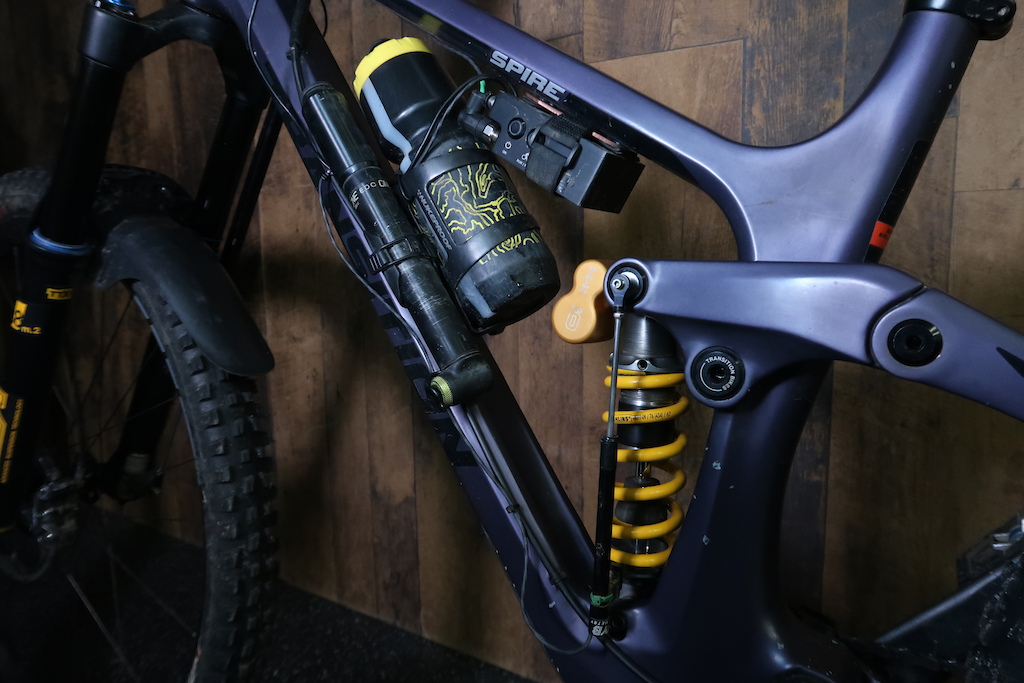
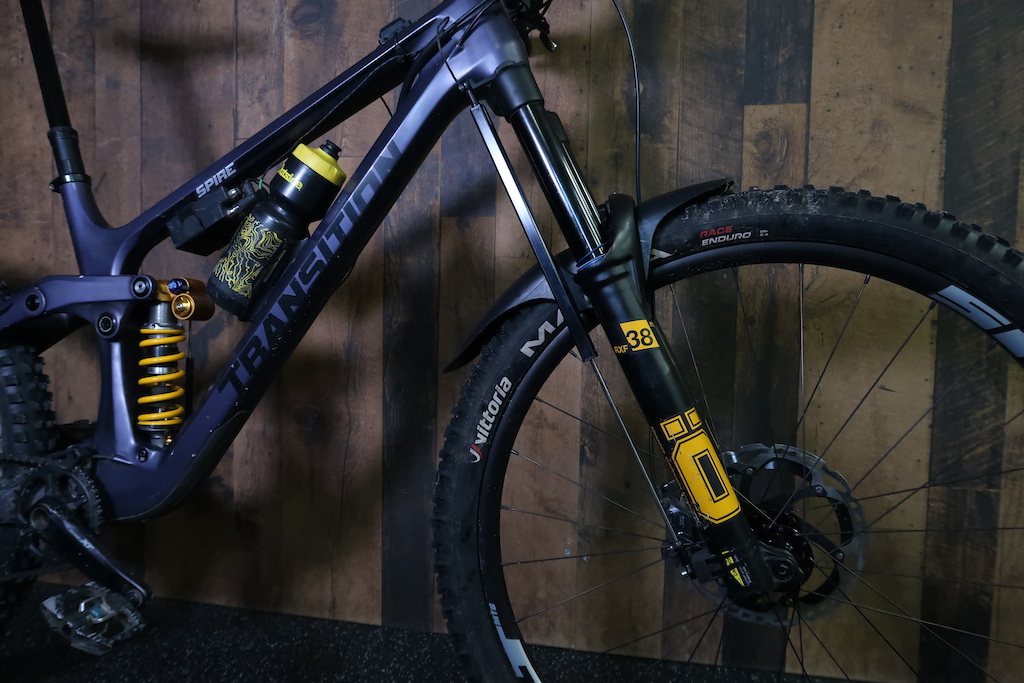





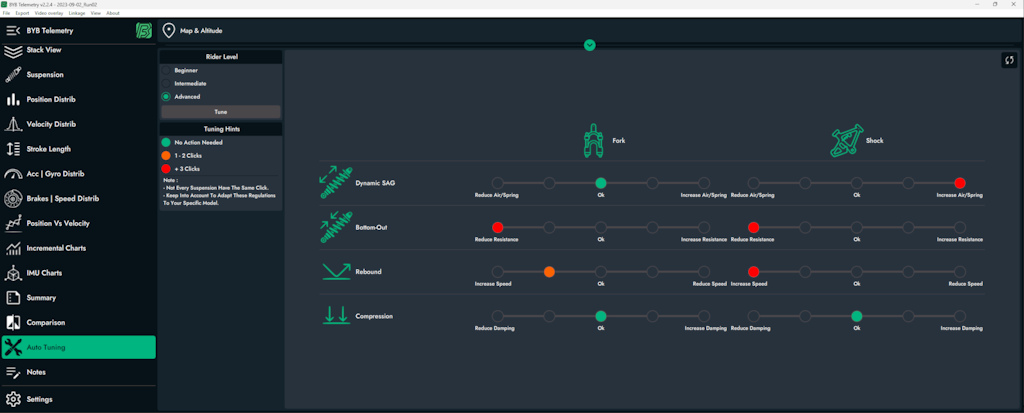
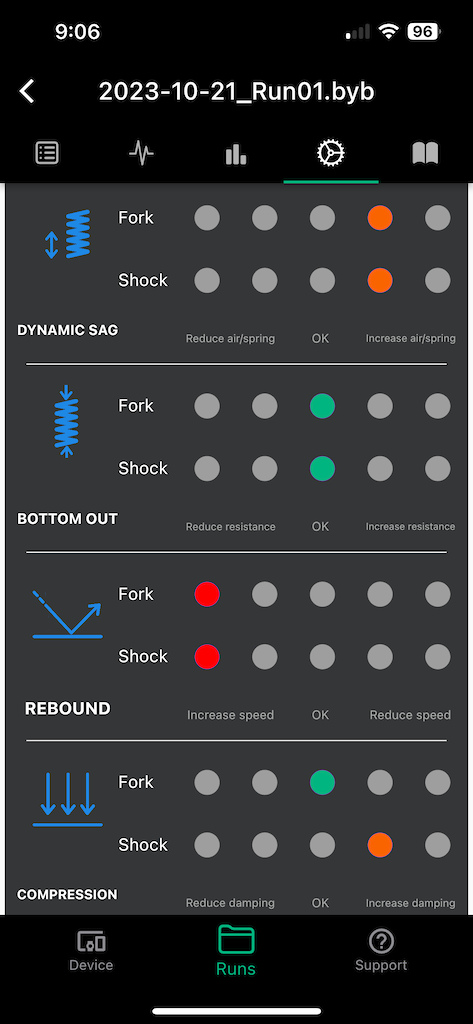



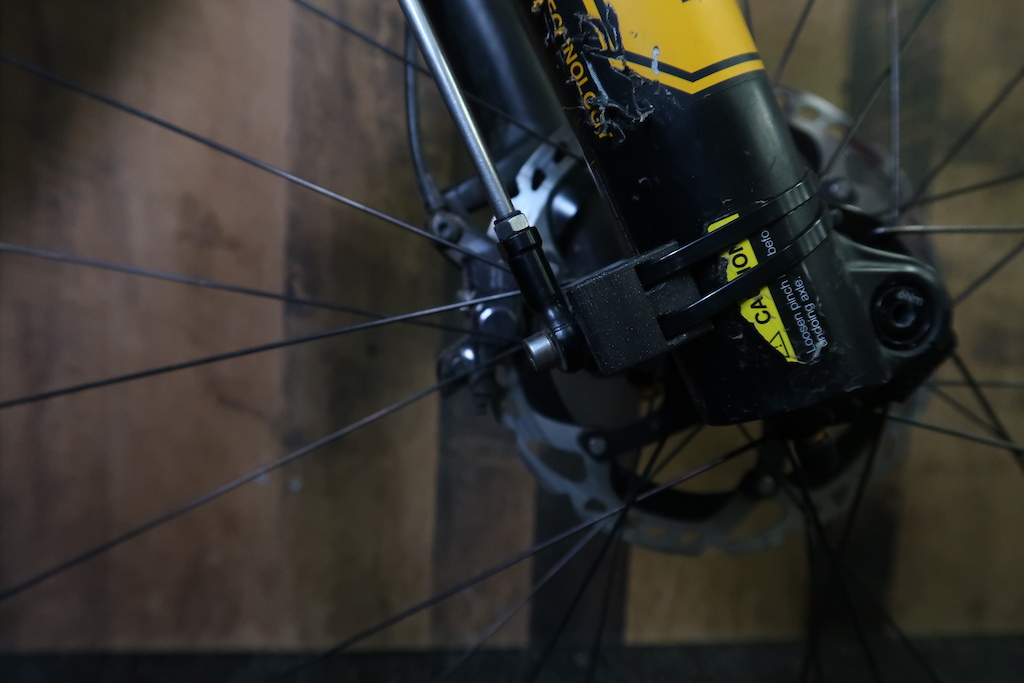


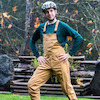
As I am using a 4D printer and based in Europe it will cost around €14k to rent the system for a month, but you will break even if you have enough kids.
It's a little safer if you have someone local, who you go ride with, and they make sure you aren't going to do anything stupid with it. Not that you'd do anything stupid with it personally, but there are a lot of stupid people who would do really questionable things then get pissed it broke and demand their money back or they aren't sending your $2k+ system back to you.
There needs to be a lower cost sensor that isn't as accurate but can work with all product types, SussMyBike's Flow was a good step in the right direction IMO but hampered by a mediocre interface.
Can recommend, again south Uk
If presented with a choice of a review on pedals/seat/grips or an in depth look at something like this, I would personally prefer to see something like this article everytime.
Biggest issue I'd imagine, particularly those on coil components, would find themselves needing spring or internal changes that could not be accomplished in a day.
Could be a cool side hustle for someone in a serious mountain bike location.
That said, if your suspension components are compatible, I think Shockwiz gets you 80% as much as BYB Telemetry and allows you to keep tweaking as parts and riding changes.
The mentioned 20 mins to fit to the bike only ever works out on your bike if you've done it a lot, every bike is different and requires slightly different mounting etc.
Also to consider into time is driving to location, set up of the equipment, constantly checking that everything is working properly, changing air pressure/springs, going through feedback loops with the rider is a huge part, even with data! Those things are just the physical time constraints, you'll also have to use linkage data for each bike to calculate the sensor/axle relationship for the software (required for accurate axle position and speed measurements).
It's totally doable as a business and is a huge help any rider, just thought I'd chip in with a bit of my own experience with regards to time and what's involved.
Cheers
Steve
In Europe @Downamics or @dialled-telemetry
@mtmc99: pricing in a range that works for both the customer and the business is the hurdle, especially in the context of marginal gains for the rider, and heavy time investment for the business. My initial thoughts were having it mostly as a value add for customer purchasing new bikes/frames, but if I can make it work beyond that I’d love to. Once I get things more sorted, I’ll happily reach out and update you with what that will look like!
@pedalhound: I am located in Victoria, but make a handful of trips up to Cumberland throughout the summer, so it’s definitely something we could make happen!
All this does is make to sport less accessible to those without the necessary funding. OK for top end racers, but for the great unwashed?
for them it's a bike ride in the woods for weirdos.
It's easy to think this might be marginal gains, for some riders who know how to get their suspension in the ballpark, that might be the case. OTOH most riders have 0 clue what to do with compression/rebound dials, barely knowing how to setup their spring properly, and they could get massive gains from one day with a system like this. I find a lot of mountain bikers are running way undersprung with rebound so slow you can count the seconds while the shaft extends, something like this that provides objective recommendations from a good data source can help tweak it and they'd get a lot of value out of it and expedite their understanding of what their bike should feel like.
If these were readily available to rent and had something like MotionIQs coaching mode, I think a day with it on the bike would help a lot of riders. I've used MotionIQ and it helped me out a lot even though I used it for a short time. I generally agree with your point re: more technology, but that ship sailed on the suspension side and helping people digest what their bike is doing can help a lot with confidence and overall feel IMO. That and, tbh, I find the data really interesting from an engineering pov, I'd think someone with your engineering background would as well
If anything, the trickle down value on low end bikes is real these days. $1000 hardtails have functional forks with air springs and usable dampers, with 1x9 wide range drivetrains, great hydraulic brakes, and tubeless ready wheels. This sport is more accessible than ever in its history. Just because the highest end bikes are getting more expensive doesn't mean the lowest end bikes are getting worse.
Either way, telemetry to optimize suspension setup might be interesting to some but it isn't for me. Telemetry to optimize your riding style I think anyone can benefit. How and when you load the pedals, the handlebars and the brakes, I think that would be amazing and I think would benefit anyone regardless of what (cheap) bike they ride. Obviously we're nowhere there yet. I don't think there is a system that can actually track how you load your handlebar.
If you can mount it near the shock (or somewhere else between rear end and front triangle for that matter) in general the speeds would be lower (~ a third of what the fork sees) so there should be fast enough string potentiometers out there for sure.
I was scouting facebook marketplace, craigslist, ect and found a 100 mm linear potentiometer for 50€...
This one is way to big to mount it alongside the shock, so you have make custom mounts and find spots on the front and rear that will move 100 mm relavitve to one another throughout full travel.
Youll have to calibrate, tho! (e.g. get the relation between what youre measuring and what the rear wheel or the shock actually does)
I like the design of it a lot. It removes the tedious and often screwed up calibration process of the ShockWiz, while remaining somewhat durable and low profile. I know it won't be as accurate as a system like MotionIQ or BYB, but it has potential to be close enough without the risks of damaged or broken sensors needing replaced ($$). The overall idea was good and the device itself seemed functional.
The problem was the software interface was AWFUL. First it came out and only supported Android, then they used some weird environment for iOS devices that was really odd and difficult to setup. It was functional but just barely. They did provide some charting/metrics for things like rebound/compression velocities and travel usage, but they couldn't be interacted with and were too abstract. They also had availability problems and it took me almost 2 years to finally get one, now their website is dead and presumably the whole thing is gone. The way you turned it on was with a magnet, too, which was a little janky IMO.
I think if they had invested in better software development for the user interface, it would be a much better alternative to ShockWiz for most people, but sadly it never really took off and I think it was due to the UI in large part. The potential was there but it needed a bit more effort and investment.
(sorry, little off-topic...)
Guess I'll try librarybiker's low viscosity juice and eventually remove a shim with the next service. Treating my fork's innards with a drill seems a bit of a dare for someone without a close relationship with a suspension guru. But I'll keep it in mind! Thanks folks!
Isn’t this ignoring a major use of the whole system? Imagine if an F1 team said ‘we’re only using our data logging to test suspension’. That would be ridiculous, of course.
A system that lets you see if certain lines and techniques are faster for a given section of track seems just as valuable to me as a system that lets you optimise your suspension, or am I missing something here?
You can optimise your suspension all you like and I'm all for it but if that doesn't translate to laptime then what is the point, it just becomes an academic exercise. It seems to suggest low spring rate/low rebound damping and some compression damping for support which is perhaps great for their suspension metrics but is it quick?
Lastly if you are looking for top notch suspension performance be sure to do a service, fit low friction seals and a coil spring (both ends); low friction is king!
I know people hate things like this, but if you can't measure changes how can you ever know if they helped or hurt? Suspension setup will always be subjective, but having things you can measure will help you dial in your subjective preference and apply it to different trails and bikes.
Thanks for reading!
I've found certain shocks like the Super Deluxe work much better with open LSC and closed or nearly closed HSC. The LSC on that shock feels very "platformy" and running less LSC and more HSC feels much more predictable and tracks better.
To me this sounds like the next step beyond suspension tuning - which to me is the best value £150 you can spend on a bike worth £4k and upwards.
Telemetry set up days that use this type of equipment are available in the UK for as little as £75 each (with 2 people minimum, plus uplift etc) which I think is a fair deal
Firstly, Henry’s writing style makes for some of the best tech articles I’ve ever read.. All that is relevant, built in counterpoints, and the inverse of convoluted.
I thought I’ve tried every possible combination, I was wrong. I thought data acquisition for suspension is worthless without the ability to revalve. I was wrong.
I’d buy this today if I could afford it. Guess I’ll try more HSC and less LSC instead.
Everything you described sounds universally better: traction, grip, more travel more often available for big hits.
The stuff about jumps is bunk, rebound settings don't have to adversely effect take-offs no matter how steep the lip is. Hitting a jump is a compression event, the rebound happens in the air: can't have an effect unless you're unloading early, which you just shouldn't be doing.
That's not the right question. Is the BYB-derived one an improvement, in any way, over the butt-dyno (and hands and feet, obvi) setup? That's the real question.
Why did you require the data? Bracketing could get you there as well, albeit probably would take longer. You don't just slam the rebound clicker wide open and rally it, you work up to it a click or two at a time. You would know that when you eventually get to wide open that it's not going to "eject me at the slightest hint of trouble", because you just rode it with a click or two more and you didn't die.
What? This doesn't make any sense. If the head tube height isn't changing as much, how could the head angle change more? It sounds like you're trying to measure them from different starting points. The head angle would seem steeper if you measure it from the line between wheel contact patches, but height would also be lower (changing more) if you measure from that same datum. If you're measuring head tube height from the rider's perspective, yes the more freely moving fork will keep that height consistent even as the local terrain height varies, but also leaves head angle consistent from that perspective (a2c and trail change from that perspective, but not angle).
Why is this so goddam hard to do?!
So yeah, learn how to establish your own base tune, start with sag and open dampers, then tweak one thing at a time.
If you like how one end of your bike behaves, and you replace the other end, see if you can get the new suspension component to "synch" with the existing component. It's not hard.
But hats off to Henry for an interesting review ... I'm just not a racer, nor am I rich enough to justify spending that kind of dough.
I just wish it were easy and simple.
Sadly nothing worthwhile is easy and simple, and I struggle with this.
Burnish bushings, build shim stacks, "service" shockingly expensive new equipment upgrade seals etc.
..in a nutshell
Beautiful!
1. Soft but not to the point that pedaling is miserable
2. Fast but not to the point that you get launched jumping
Buying ultra tuneable suspension, and then let down by the lack of understanding and riding experience...
A simple hidraulic tune (Rebound/Compression) makes magic to those who just want to ride
My riding weight, minus 6psi
LSC- 16 out.
Rebound- 16 out.
The difference is massive. It’s now more plush off the top than my Ohlins shock!
The obvious point is that fork needs to run inside a very small window of travel to work, and that window puts it’s very high in the travel, because it’s not just spring/damping, but also linkage progression.
Would this tool have gotten me there sooner? Would it have gotten me there at all..?
Now that it’s good, the Ohlins TTX-2 shock follows.
If this telemetry can get me to where I am now or better, I’m sold.
But again, it raises the question of which tool will be riding this bike? The telemetry or me!
This would be 10x more distracting thinking about every comp and rebound input the entire ride and if its "optimal".
...and for very marginal gains... and its $2000 USD! wtf.
Maybe if your a WC pro or aspiring to be one. Spend that on skills clinics or a nice MTB vacation and have fun..
I